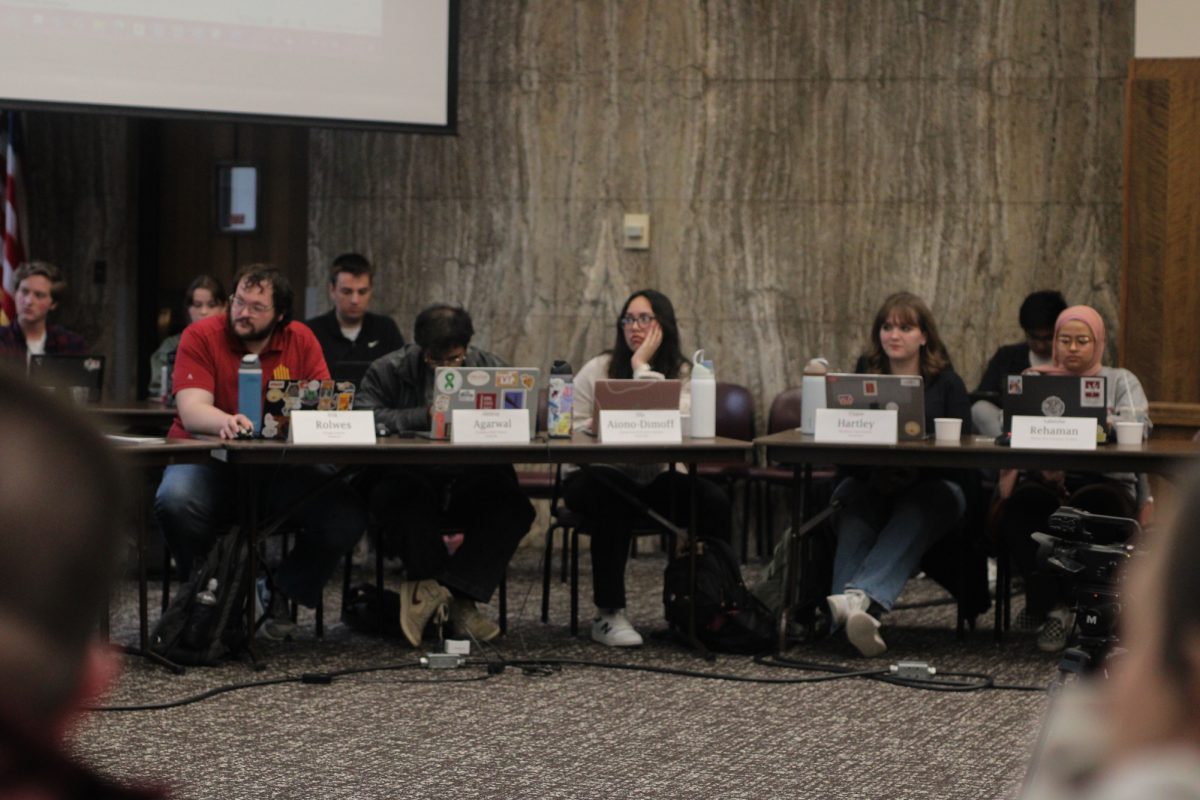Cyclones Sports Complex discussions continue
Photo: Huiling Wu/Iowa State Daily
Mark Schmitz makes commands during the New Sports Complex meeting on Tuesday, Feb 15 at Knapp Storms. He says he supports student facilities, but he is considering his home as well.
February 15, 2011
The crowd that filled the Knapp-Storms Dining Complex described itself as “the community of Iowa State.”
There were ISU alumni, faculty members and athletes mixed in with the communities of Storm Street and Ash Avenue, the areas immediately surrounding the proposed site of the Cyclone Sports Complex.
Tuesday night, the community gathered for the second time to discuss the proposed plans with Warren Madden, vice president of business and finance, and Jamie Pollard, ISU director of athletics.
“We’re [ISU] people,” said Jean Liles, ISU alumna and 36-year Ash Avenue resident. “We’re all a little scared and we want things addressed.”
The thing the Ash Avenue community most wanted addressed was the drainage problem potentially posed by the construction of the facility, set to be the new home of the ISU track, softball and soccer teams.
The neighborhoods in the area already operate with an “aging infrastructure,” said Barbara Pleasants, adjunct assistant professor of ecology, evolution and organismal biology and Lynn Avenue resident.
That infrastructure results in basement floods that occur with regularity during the summer months, and not necessarily during floods like those Ames had in August.
“Of a great concern is the water issue,” Pleasants said. “Our homes were all built [between] 1900 to 1920, almost all of them. We have a very old infrastructure.”
“Anything that adds to the burden of that old infrastructure is of great concern.”
The site is currently intramural fields and green space east of the Towers residence halls.
With the addition of a 1,500-seat stadium, a hard-surface track, increased plumbing and sewer usage and irrigation of field turf, runoff from the site is sure to increase.
Several times throughout Tuesday night’s meeting, community members asked Madden for answers on how the city and university planned to handle water disposal, aside from the water retention area designed into the complex schematics.
Each time, Madden deferred to the lack of engineering plans, which won’t be drawn up until after the Board of Regents approves the Complex’s schematic design.
“We will be responsible for managing the water on our land,” Madden said. “We are committed to do that. And I have every expectation that as this plan moves forward that will be one of the conditions subject to continuing on to develop this contract.”
Community members were not entirely content with the answers provided.
“I’m disappointed that we have another meeting with concerns about water, and there’s nobody here to answer the questions,” said Michael Burkart, associate professor of geological and atmospheric sciences and Ash Avenue resident. “That’s really frustrating.”
Madden said that after Board of Regents’ approval, the university would begin detailed planning and hiring engineers to design water management systems.
After those plans are drawn up, the plans would have to be approved by city engineers and the Department of Natural Resources before construction could begin.
“We’ll take the comments that were made and see if there are ways we can improve this site,” Madden said after the meeting’s conclusion. “I personally don’t think there have been a set of ideas that would cause this to change hugely.”
“It’s still a work in progress, so there certainly can be improvements made. I would expect that would continue to happen.”
Madden also made a commitment near the end of the meeting to meet once more with a small group of representatives from the community, but no time for that meeting has been discussed.
Throughout the meeting community members questioned the facility’s location while debating potential problems with noise and light pollution, and the aesthetics of the site.
Sites such as the existing Southwest Athletic Complex, the university’s old dairy farms and moving the plans slightly to the west were all proposed.
Madden said the Southwest facility incurred an additional $2.5 to $3 million in site development, while the old dairy farms are to become the new home of the Department of Agriculture and Life Sciences’ horse operations.
“There’s a lot of other green space,” one community member said. “Is this becoming the condition of ‘This is my property and I’ll be damned if anyone’s going to tell us what to do with it’?”







